mutato
Rookie Solder Flinger

Posts: 11
Likes: 0
|
Post by mutato on Sept 9, 2008 11:45:23 GMT -5
Hi,
Has anybody here added a Master volume to a Princeton Reverb? I recently acquired one ('77 with the Push/Pull Boost feature, which isn't so evil after all!) and would like to take advantage of having more control over my volume to breakup at room levels. I'd use the rear ext speaker jack hole so as not to drill anything.
For reference, I also have a Blues Junior which I've had for years, which works pretty well with a MV. I usually can get decent crunchy breakup with the volume on 5-6 and the MV on 2-3.
I'd like to be able to do roughly the same with the Princeton Reverb. Just to get it in the early breakup crunch range, which in my amp is around 5-6 on the volume. But that's fairly loud. Not for me alone, I'm used to it, but when I jam with some friends (without drums), I'd have to keep it around 2-3 for levels.
Thanks,
Mutato
|
|
|
|
Post by ChrisK on Sept 9, 2008 20:17:12 GMT -5
I presume that you mean pre-amp distortion.
It'd be easier to just use a tube screamer or external preamp. I don't know how much "vintage value" a '77 has (or will have), but it'll be more without it being modified.
|
|
|
|
Post by ashcatlt on Sept 9, 2008 22:47:46 GMT -5
Does the internal speaker have a 1/4" connection, or is it hardwired?
Get an old toaster and wire it in series with the speaker. You need to defeat the thermostat to keep it from popping up. I'd imagine a sudden open on the speaker out would upset the power amp section.
|
|
mutato
Rookie Solder Flinger

Posts: 11
Likes: 0
|
Post by mutato on Sept 10, 2008 8:18:05 GMT -5
I am assuming preamp distortion. That's what I'm hearing with the Blues Junior setup. Is the preamp section similar in nature in the Princeton Reverb to take advantage of it better?
|
|
|
|
Post by newey on Sept 10, 2008 12:39:25 GMT -5
I'm with Chris here- This amp, if kept original, is only going to go up in value.
If you like the Blues Jr, why don't you just use that for jamming without drums, and use the Princeton when more amp is needed, like for jamming with drums or small gigs?
|
|
|
|
Post by ChrisK on Sept 10, 2008 12:48:16 GMT -5
I'm with newey here, - This toaster, if kept original, is only going to go up in value. It will take more than a TubeScreamer to agitate a Princeton enough to operate the toaster anyway. Preamp distortion, which is asymmetrical compression and cutoff clipping of a single ended class A stage, is often called "crunch". This is affected by the gain and signal levels within the preamp circuits (you know, those 12AT/U/X7 twin-triode input stages. Power amp distortion, which is usually symmetrical compression within a push-pull power amp output stage (EL34/84, 6V/L6), is often called the "brown" sound (although one can have a single-ended output stage - which is all just plain crunchy). This is affected by the preamp levels and a master volume if you have one. In essence, having both enables one to dial in crunch separate from output distortion and power level. If one doesn't have a master volume, one can use an "L" pad variable power resistor as a power attenuator. For the Princeton, get a 25 watt on or more. Search a'web for "L pad". One can also make an attenuator with power resistors in an aluminum box. It's easy, and with speaker jacks, it can be used on other amps (up until you melt it). I have this amp, it has a volume/gain control on just aboot every stage. It has too many knobs. But I have full control over my crunch AND burn........  |
|
|
|
Post by ashcatlt on Sept 10, 2008 21:56:13 GMT -5
I was asked to explain the toaster thing. No I wasn't kidding. I think it was Zakk Wylde couldn't get enough distortion out of his amp without killing people. So his dad modified a toaster. Somebody said something about a power resistor? What do you suppose the coils in the toaster are? Light bulbs and fan motors can be used for this as well, and present a "reactive load" more like that of an actual speaker.
Google Power Attenuator. Or I'll do it later and post some links, but Everybody Hates Raymond is on...
|
|
mutato
Rookie Solder Flinger

Posts: 11
Likes: 0
|
Post by mutato on Sept 11, 2008 9:21:29 GMT -5
Thanks all for this info. Helping me understand what I need.
The Blues Junior is partially funding the PR purchase and is regrettably going to have to be sold off. I love the features of the amp and overall sound, but it was lacking in really bright clean tones that I'm getting in my PR. Also, I was missing the awesome surf reverb and tremolo like I had in in my years ago '65 Pro Reverb.
I will look into these things:
Good OD pedal - I currently have an early 80's TS9 modded by Analogman to TS-808 specs. It's good, but really changes the tone by punching mids a lot. I think I need a OD pedal that keeps the overall tone the same for the guitar. I'd keep the TS9 and add a second OD pedal. Any suggestions welcome!
Power attenuator - Look into one. But I really like bright, jangly tone as well. I've heard some are tone robbers. I guess I'd have to play one to really see.
|
|
|
|
Post by ashcatlt on Sept 11, 2008 23:39:11 GMT -5
Assuming you want to get the "sound" from the Princeton itself, I'd go for a clean (and flat) boost. Here's a link to a very simple transistor boost circuit. Looks to me like the input-Z on this is a bit low, but I'm likely missing something. I personally would go with a simple op-amp boost. Just because transistors freak me out.  Can't seem to find a good schematic right now. Would be the same as a basic opamp buffer (scroll down, the 8th and 9th pics) only with a reostat in the feedback loop. Here's another transistor based booster. BTW - here's a (non-toaster related) power soak for low wattage amps Edit - meant to mention that I've read (and it makes sense) that you can achieve power amp distoring by reducing the "B+ plate voltage" on the power tube(s). This, however, involves voltage that I don't want to play around with. |
|
mutato
Rookie Solder Flinger

Posts: 11
Likes: 0
|
Post by mutato on Sept 12, 2008 10:05:23 GMT -5
Hi,
Last night I played both my Princeton Reverb and my 90's era tweed Blues Junior for a side by side comparison (using a '92 USA 62 reissue Strat). I set the master on 10 for the BJr so they were both similar in setup. Now note that the speakers are very different. The BJr has a C12N type speaker (stock Fender 50 watt). The PR has a Jensen C12R (25 watt) speaker. The C12R alone brings a TON of jangle and brightness to the PR. The C10R is the standard speaker on most 60’s PR’s. When I bought the PR, it had a generic Fender replacement speaker (Eminence no label type), which was actually very similar to the BJr. It was less bright and more midrange heavy. It had a larger magnet.
But the main thing I did was play both at full volume to hear the distortion characteristics of each. Here's some insights I had:
-------------------------
PLAYED FULL VOLUME (10)
Blues Junior sounded a lot louder at 10 that the Princeton Reverb. More Bass as well. Probably from the larger wattage speaker. Scary how loud it can get! When you have it 6-7, it had a nice warm distortion. It just oozes blues. I think that's its strong point in design.
The Princeton Reverb, with the stock-type speaker, has a lot of brightness which you have to turn down to get some bluesy distortion out of. Otherwise it gets raw sounding. Seemed to have slightly less distortion. If I was thinking blues all the time, I would have kept the speaker it came with or get a blues friendly speaker.
-------------------------
PLAYED MEDIUM/LOW VOLUME (3-5)
Blues Junior sounds overall pretty flat in terms of frequency response. You can't really take out the mids. It kind of dominates. Even with the Mid turned down all the way, you still have a lot of mids and not enough bright end (for me).
Princeton Reverb has a really nice jangle and thinness to the sound. More scooped. The speaker is really accentuating that. It pushes the brightness (if treble on 10), which gives you that Clapton "Let It Rain" type Strat sound. Not everyone's cup of tea. But I love having the option to dial up the treble to get that. You can always turn it down for warmer sounds. It also helps with brightening my dark sounding ES335.
-------------------------
CONCLUSIONS:
Noodling factor:
I do like the “noodling” ease of use with the BJr where you sit down in front of it, turn the volume to around 6-7, Master on 1-2 and jam away some Blues licks without killing your ears. The PR is more of a clean “noodling” amp at lower volumes. For me to have more cranked sounds, I have to plug into boxes to get that.
Love to keep both! But I think I really need to have the better clean sounding amp, which the Princeton Reverb gives me and couple it with a good distortion/overdrive pedal. When I jam, it’s mostly clean rhythm playing with distorted solos dropped in. I also want better spring reverb, which the PR has. The Blues Junior’s is mediocre.Having a tremolo is just add-on gravy. I also play with three different types of guitars: Strat, ES335 and a Ric 330/12. The ES335 being the darkest sounding. All three guitars really shine with the PR.
Speakers play a major role in the tone. I chose the brightest speaker I could because I love that jangly, raw sound. Think early Johnny Cash picking, Surf style stuff, etc...
To do: I’m going to try and play the Blues Junior through the PR speaker and cab using an extension cable. Curious to hear how the speaker sounds with it. If I do, I will post my thoughts on that as well. Also,will still look into attenuators. I also own a 60’s era Gretsch 6150T amp, which could be a nice candidate for attentuation. That thing rocks with my ES335.
External speaker cab: I’d love to get one so I could take advantage of bigger sounds from both the Princeton Reverb and the Gretsch amp. I think my favorite sounds are from these low wattage amps.
|
|
|
|
Post by ashcatlt on Sept 12, 2008 23:52:54 GMT -5
This is not what I described, but it is a fairly simple opamp booster. Appears to have some frequency dependent gain characteristics...
|
|
jaybird
Rookie Solder Flinger

Posts: 2
Likes: 0
|
Post by jaybird on Sept 13, 2008 22:56:32 GMT -5
I own a "76" Princeton reverb SF that came with a modified master volume that works real well for adding some grit. It appears to bea simple 250k volume pot on the rear panel that has a wire leading to each of the 6V6's. a rather reversable mod.   |
|
mutato
Rookie Solder Flinger

Posts: 11
Likes: 0
|
Post by mutato on Sept 17, 2008 9:51:21 GMT -5
Hi,
Thanks for the pix! Is this the standard type of Master Volume mod? Are there varying types? I think I'd like to explore one. Also due to the fact that I have extra gain with my Pull Boost feature. I actually like that feature. Of course, you have to drop the Treble to around 3 to make it sound good. I will eventually get around to fining a local amp tech who I can talk with about these ideas.
|
|
|
|
Post by ChrisK on Sept 17, 2008 11:29:53 GMT -5
jaybird, Welcome a'board. If it is just two wires, one going to each 6V6 socket, what I can think of is a gradual shorting together of two signal points. I'll have to look in my copy of the Pittman Tube Amp Book to see what might be going on for sure in a real '76. Do you know which numbered pins on the 6V6's that the two wires go to (it sure looks like pin 5 - grid)? Here's a schematic link for the current reissue '65 Princeton Reverb. www.fender.com/support/amp_schematics/pdfs/65_Princeton_Reverb.pdfIn this design, gradually reducing a resistance between the two output tube's grids will have a volume/drive reducing effect. Each 6V6 has a 220K resistor (R18, R19) from the bias/tremolo point to each grid. One grid is driven by a signal that is 180 degrees out of phase with the other grid. Although some grid current can flow (not necessarily desired) the output load seen by the phase inverter (V4-B) is the 440K series combination of these two resistors. A potentiometer across the grids will have the effect, in conjunction with the 1K5 grid series resistors (R8, R33) of reducing this load impedance which, in concert with the minimum output impedance of each side of the phase inverter of 56K (R17, R26), will attenuate the drive signals at each grid. This is further exacerbated by the 0.1 uF coupling capacitors (C10, C16), which were not specified for driving a significantly lower load impedance such as effected by the shunting pot. This will have the effect of reducing the low frequencies more than the high frequencies. In essence, this shunting (decreasing the pot resistance) reduces both the drive and low frequencies of the signal effected at the power tube grids. This enables one to turn up the regular volume control to effect more preamp asymmetrical distortion (crunch if we must) without also increasing the output power. Once the crunch is set, then the power output stage can be set for the desired power/burn/brown level. Note that when this is turned up (increasing the pot shunting resistance), the signal will get louder and fatter as more low frequencies are coupled thru to the output stage. |
|
|
|
Post by ashcatlt on Sept 17, 2008 21:35:16 GMT -5
|
|
mutato
Rookie Solder Flinger

Posts: 11
Likes: 0
|
Post by mutato on Sept 18, 2008 9:19:54 GMT -5
You know, I bet these things are going to be discontinued very soon. The one sitting at my local Guitar Center has it listed at something like $750! Yes, that might be the floor model they're trying to get rid of...
I played through it and it sounded fine. I'd rather have the regular amp (reissue or original) so as not have more things apt to break inside. They've already had people complaining of broken attentuator knobs because if you transport the amp laying flat, it breaks the black (plastic shaft anyone?) knob. I found my SF '77 for $650.
|
|
|
|
Post by newey on Sept 18, 2008 10:05:27 GMT -5
I doubt that MF knows about this thread, but they do know about the reviews their customers have written, so I suspect that's why these things are on sale.
All reviews were negative and several complained specifically about the attenuator.
Of course,other than the fact that it says "Princeton"* on it, not similar to what Mutato has. But, all in all, the suggestion to use a pedal instead might merit a second look!
* Fender also made a "Harvard" and a "Yale" as I recall, during this era. Not sure if there was a"Dartmouth" or a "Penn" also. With all those Ivy-League amp names, they must have had frat boy bands as their target group.
|
|
|
|
Post by ChrisK on Sept 18, 2008 16:10:43 GMT -5
Yeah, who else in school had the petty cash for stuff back then.
|
|
|
|
Post by mr_sooty on Nov 3, 2008 15:35:32 GMT -5
A great transparent overdrive with much less mid hump than a tube screamer is the Boss Blues Driver. Yes, that's right, I said Boss. But this is a lot better than most Boss Overdrives. It's actually a really great sounding pedal that won't colour your tone. Another option is building a Marshall Blues Breaker clone (MBB) from www.generalguitargadgets.com. This is pretty transparent too, although it is quite bright. It can be easily modified though to be slightly less bright with my newly aquired knowledge (thank's ChrisK). |
|